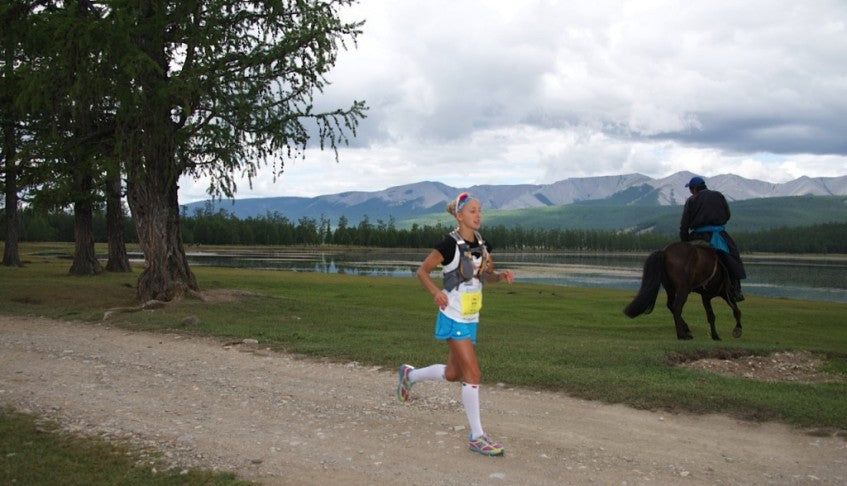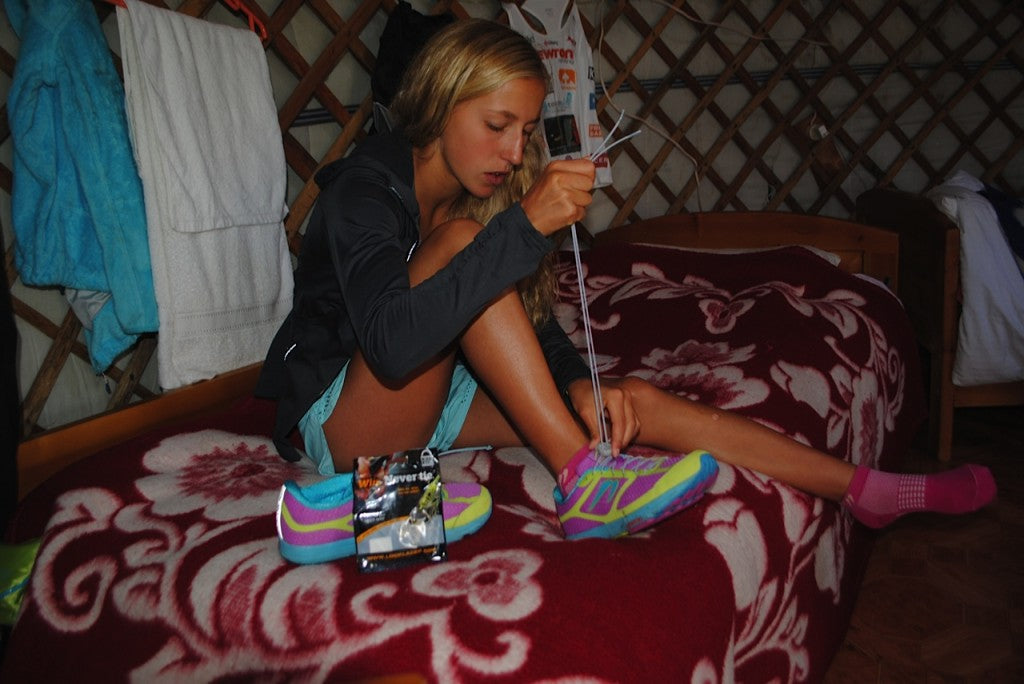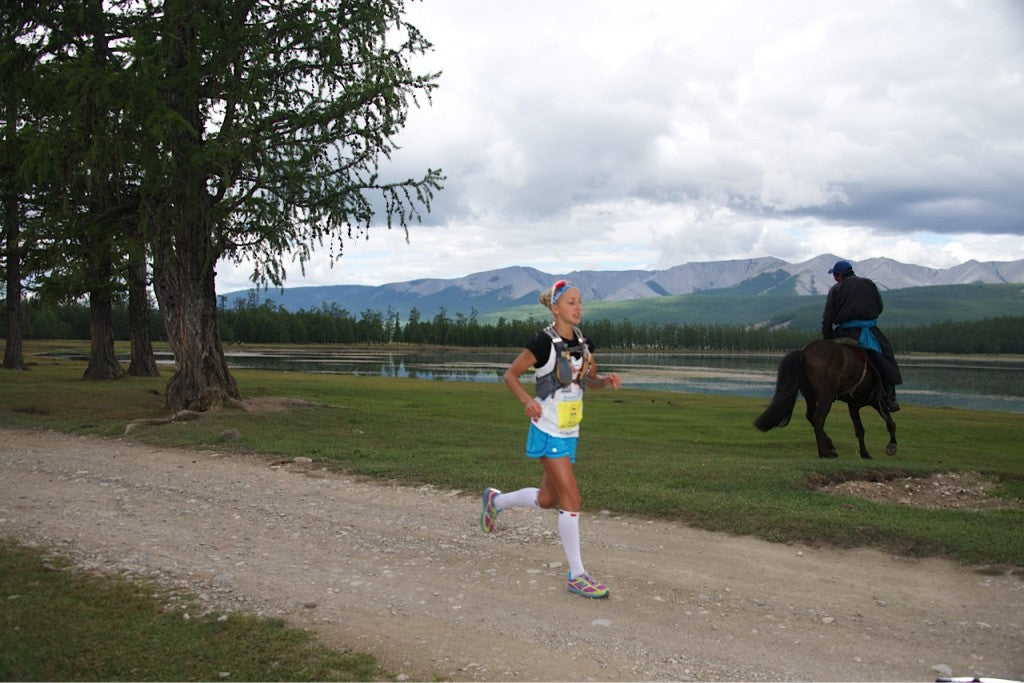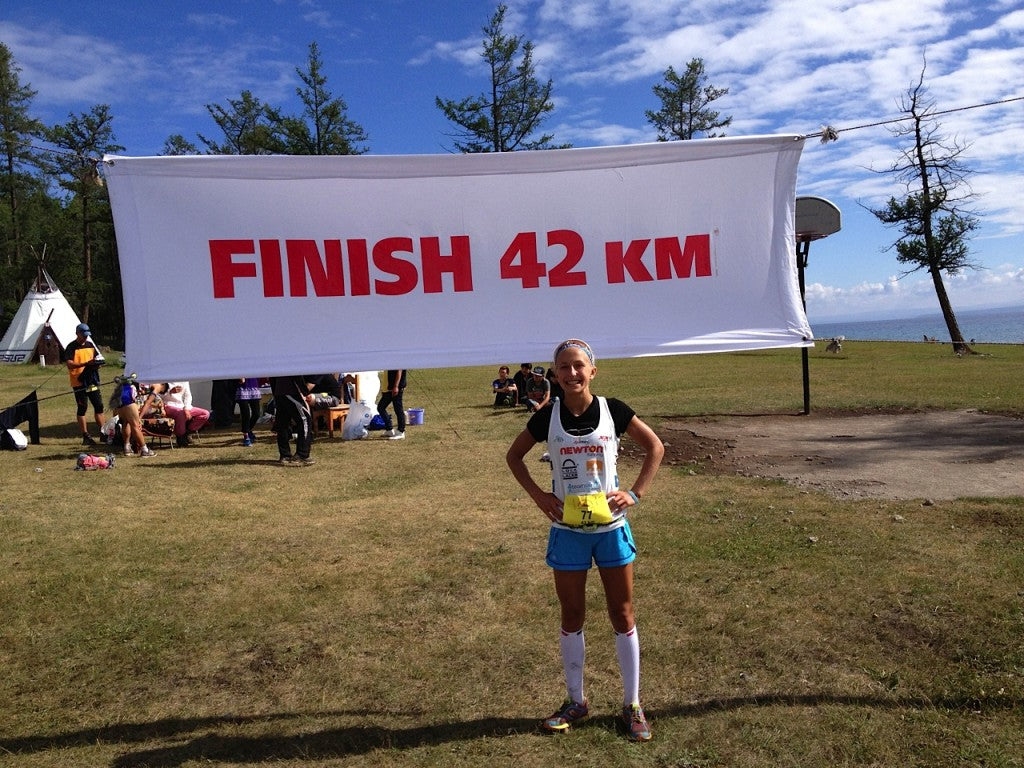
Mongolia Sunrise to Sunset
uncategorized6 September 2013
My Newtons and I Run Mongolia — Continent #5
Getting There
In August, I spent a week in a Ger—the Mongolian term for a Russian yurt—in remote northern Mongolia. Morning views were of the sunrise over Lake Hovsgol, the “Mother Lake”. Reflections of the distant mountains were painted across the still water. The mornings were so quiet, that if one looked hard enough, they might envision Chinggis Khaan and his men roaming the countryside on horseback. His legend lives across Mongolia. I knew the journey would be long, but the rewards of visiting a country with so much history would be worth the challenging travel.
The journey to Mongolia took two days. I left Portland, Oregon and made a quick stop in Seattle, before the long flight across the Pacific Ocean. Spending several hours on a layover in Seoul, Korea was a very surreal moment for me. At just 14 years old, I live away from home and my family. My days are spent training at the Utah Olympic Park in Park City, Utah, with aspirations of making the 2018 Winter Olympics in aerial skiing. It just so happens, that those Olympics will be held in South Korea. I walked through the airport that day knowing that I will hopefully return here in 2018, with my skis in tote, chasing my Olympic dream. Many people don’t realize, the many purposes my running serves. Running is great cross training for so many sports, especially skiing. I believe my cross training as a triathlete and runner give me an added advantage as a skier.
A three-hour trip from Seoul put us in the capital of Mongolia, Ulaanbaatar. I would later learn to call it UB, as it is known amongst the locals. We spent one evening in UB, where I witnessed how underdeveloped the area was. Many of the main roads were dirt with patches of broken up concrete. A layer of dust rose above the city and mixed with the pollution from the four coal power plants used to power the city. The total population of Mongolia is 2.8 million with more than 1 million alone living in UB. Childhood obesity is as much an epidemic here as it is in the U.S. The major contributing factor is felt to be the lack of vegetables and outdoor activities, which is compounded by the extreme cold temperatures.
Yet another early morning flight, one-hour north, put us close to the border of Russia. Russian minivans took us on a three-hour drive to Camp Toilogt. For the past 15 years, this camp, mostly visited by fishermen and avid horseback riders, has had about 70 runners converge on it from around the world to run the annual Mongolia Sunrise to Sunset 42 km and 100 km trail run in Hovsgol National Park.
I have been to remote areas in Kenya and Peru, but wasn’t quite prepared for what I would face in Mongolia. Most of us faced nutritional challenges the week leading into the race. We did not anticipate such a lack of fruit, vegetables, and the protein rich food that most athletes live on the days leading up to races. Refrigeration was limited, the dairy products were unpasteurized and rice was the main staple. The main water filter for the camp had broken so keeping up with fresh water meant boiling the water. Many of us tried to keep up on hydration by drinking the warm water or trying to cool it in our water bottles, which we submerged in the lake. Camp was at 5,000 feet, so runners needed to pay close attention to staying hydrated. I normally try to pack dried fruit, oatmeal, and bars, but was limited due to weight restrictions from the airlines. I definitely fell way short on my stash of pre-race food for this event. Luckily my stomach tolerated the change of nutrition fairly well, but others were less fortunate.
Despite not having ideal conditions leading up to race day, everyone’s spirits remained high. Fourteen of the 70 race entrants were runners from all over the world who I had previously met at my second marathon in Kenya, the Amazing Maasai. We developed friendships and a running bond. We had decided to all meet up again in Mongolia, almost a year after the marathon in Kenya. We were also reunited with the Canadian filming crew, Boundless. They had filmed a segment with us in Kenya as part of their first season debut. Intrigued with my story in Kenya, the filming crew was kind enough to put together a great video about Team Winter. Having them join us in Mongolia and include us in their second season of filming was so much fun. The filming crew added a dynamic to camp and even caught my first “Hash Run” on film. (Hash Runs have now been modified so that non-drinkers and young people like me can participate as well.)
RACE DAY
Race morning was a 2 am wake up call. My mom had the usual morning fire already going. She would have a pot of hot water on the tiny stove that warmed our four-man Ger. The hot water would be used to make my pre-race oatmeal, which I had rationed specifically for race morning. Generators were used only two hours each evening to recharge phones and computers, but an exception was made race morning to provide early morning light. The weather was a runner’s dream, low 50s no wind and slightly overcast. The clouds would chase us up the mountain passes all morning, but never catch us. About 70 runners, 33 for the 42 km and 35 for the 100 km lined up for the 4 am start. I was running the marathon, or 42 km.
By the pace of the first 100 yards of the race, you would think we were competing in an 800-meter sprint. The first 2.5 km’s of the course was very technical singletrack through the woods. The roots, low hanging trees, and stones made the trail—lit only be our headlamps—difficult for us to navigate in the darkness. Most of the top runners knew it would be difficult to pass during this section so there was definitely a race for positioning at the beginning. To my amazement, as I navigated the darkness with the lead pack, I would catch glimpses of the camera crew running the woods parallel to us trying to capture vital footage. The next 12 km were still in the dark along a rocky road next to Lake Hovsgol. The clouds hid the morning sunrise as we began our first ascent.
After a rewarding first climb we were greeted with a steep rocky descent with much loose stone, making for a difficult downhill run that didn’t allow for much recovery. There had already been many early morning falls by most of the runners, but luckily no serious injuries. By mostly pure luck, I managed to stay on my feet for the entire 26.2 miles.
The second climb humbled many of us, including myself. It was a steep climb through a mossy, dense forest that never seemed to end. I would occasionally find myself glancing around hoping to catch a glimpse of an area that might be the location of Chinggis Khaans’ burial site. To this day, no one has been able to identify the exact location of his tomb. At the summit of this second climb, stood an Ovoo, a spiritual triangle of stones and flags that are found throughout the land and especially at the highest points of elevation. These are sacred areas thought to house the spirit of the dead. It is good luck to circle them clock-wise either once or three times and place offerings. Of course, I made my offering and circled three times before continuing on in the race.
Three aid stations filled with water, potatoes, tomatoes, and homemade donuts would be the only source of spectators on the course. An occasional sighting of the filming crew in the most obscure, remote locations would be the only other sign of life. There wasn’t a single time during the race that one couldn’t think about their foot placement due to the rocky nature of the course. The course proved a challenge to many runners. One person got lost for several hours and many of the 100 km runners quickly realized at the 42 km mark that the course would be too much to continue on. In the end, only about half of the 100 km runners that set out that morning actually complete the entire course. Many realized the 18-hour cut-off would be difficult to achieve and were happy to settle with 42 km. The last 42 km runner crossed the finish line in about 10 hours.
The course lived up to its name, “The Most Beautiful 100k” and definitely can be considered one of the more challenging races. I was pleased with my 5:55 finish and taking second place overall female. I have fallen in love with the challenges that trail running offers. I continue to learn much about running and most importantly about myself. Through my running, I’m not only able to raise awareness for prostate cancer, but to show that age and gender are not barriers! I am now just two continents away from setting a world record for the, “Youngest person to run a marathon on all seven continents”. I will be headed to New Zealand in October followed by the completion of my World Marathon Tour in Athens, Greece in November.
As with every race, I learned afterwards of the unsung heroes that had run amongst us. Running in the Mongolian Sunrise to Sunset, were some of the 1 in 6 men I run for. After the race, they came to me and shared their stories of family members affected by the disease or their own personal story of battling prostate cancer. I learned that prostate cancer survivors had been out there running the 42 km and 100 km in silence, a silence broken only by the presence of a 14 year-old girl out there running with them and for them. May they “Never Give In!”
*** Although one in six men are diagnosed with prostate cancer, awareness and screenings remain extremely low. Help me to bring attention to this disease that affects almost every family worldwide during September—Prostate Awareness Month—by joining Teamwinter S1X, a month-long charity “run raiser” to raise money and awareness for prostate cancer and research by converting daily running or walking miles into dollars. Like run/walkathons, S1X participants invite friends, family, and colleagues to pledge dollars (or cents) per mile they log running or walking throughout the month of September. Activities are tracked on www.athlete.com/s1x and all proceeds benefit prostate cancer research and awareness.
As a bonus, S1X participants receive a “S1X Pack—with over $200 in swag,” and Athlete.com is awarding the top six men and women with the most money raised, most miles run, and first to six hundred with awesome prizes. There will also be great random raffle drawings—and participants can increase the odds by getting an extra raffle ticket for every $10 they raise. It isn’t too late to still register! Register here.
Never Give In!






